Risk Analysis in Hospitality Industry
VerifiedAdded on 2020/04/01
|19
|3752
|171
AI Summary
This assignment analyzes various risks that can arise in the hospitality industry, specifically focusing on the Star Gold Coast hotel. The report identifies potential threats such as credit card fraud, public assault, theft, and fraudulent identities. It proposes solutions to mitigate these risks, emphasizing the importance of identity verification, robust security measures, and effective risk management strategies.
Contribute Materials
Your contribution can guide someone’s learning journey. Share your
documents today.
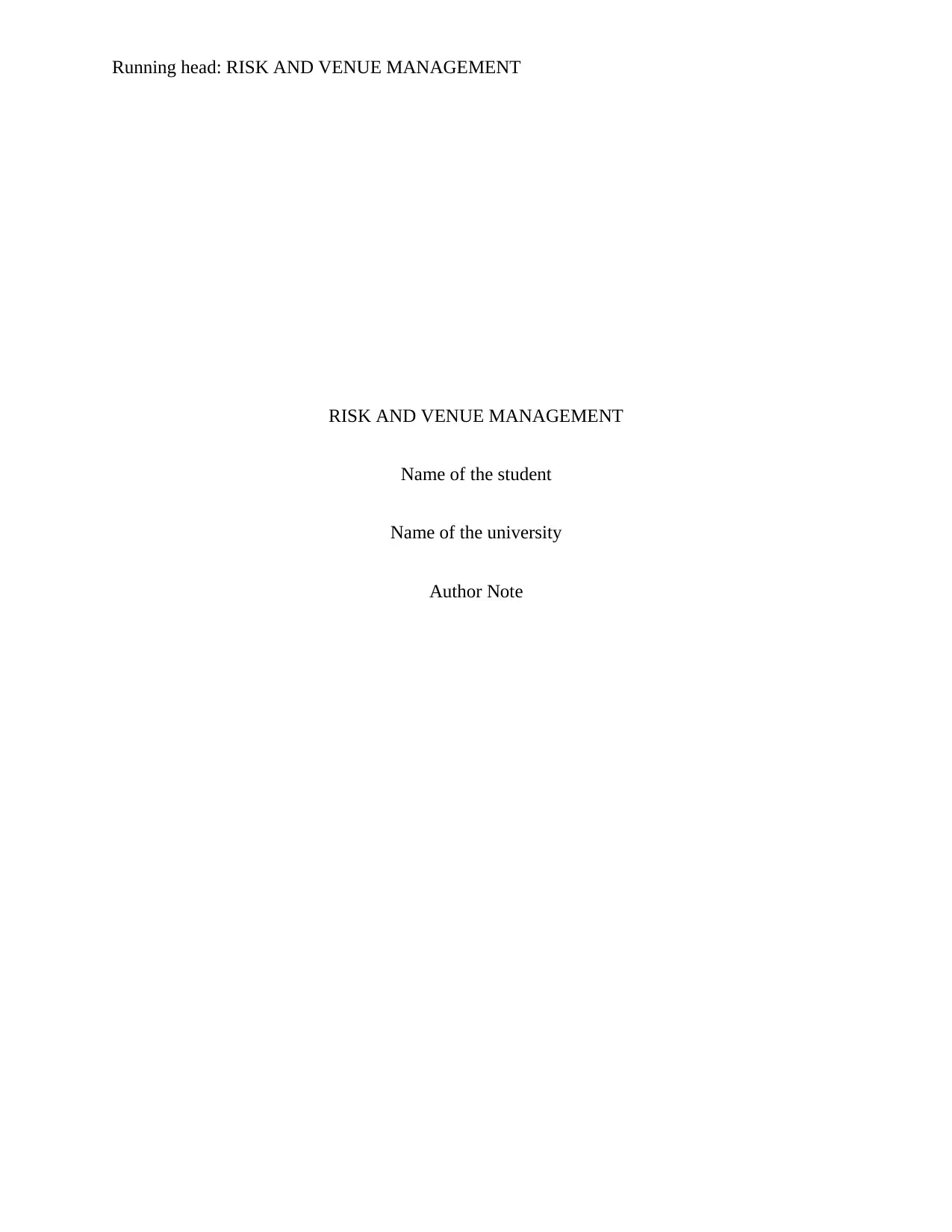
Running head: RISK AND VENUE MANAGEMENT
RISK AND VENUE MANAGEMENT
Name of the student
Name of the university
Author Note
RISK AND VENUE MANAGEMENT
Name of the student
Name of the university
Author Note
Secure Best Marks with AI Grader
Need help grading? Try our AI Grader for instant feedback on your assignments.
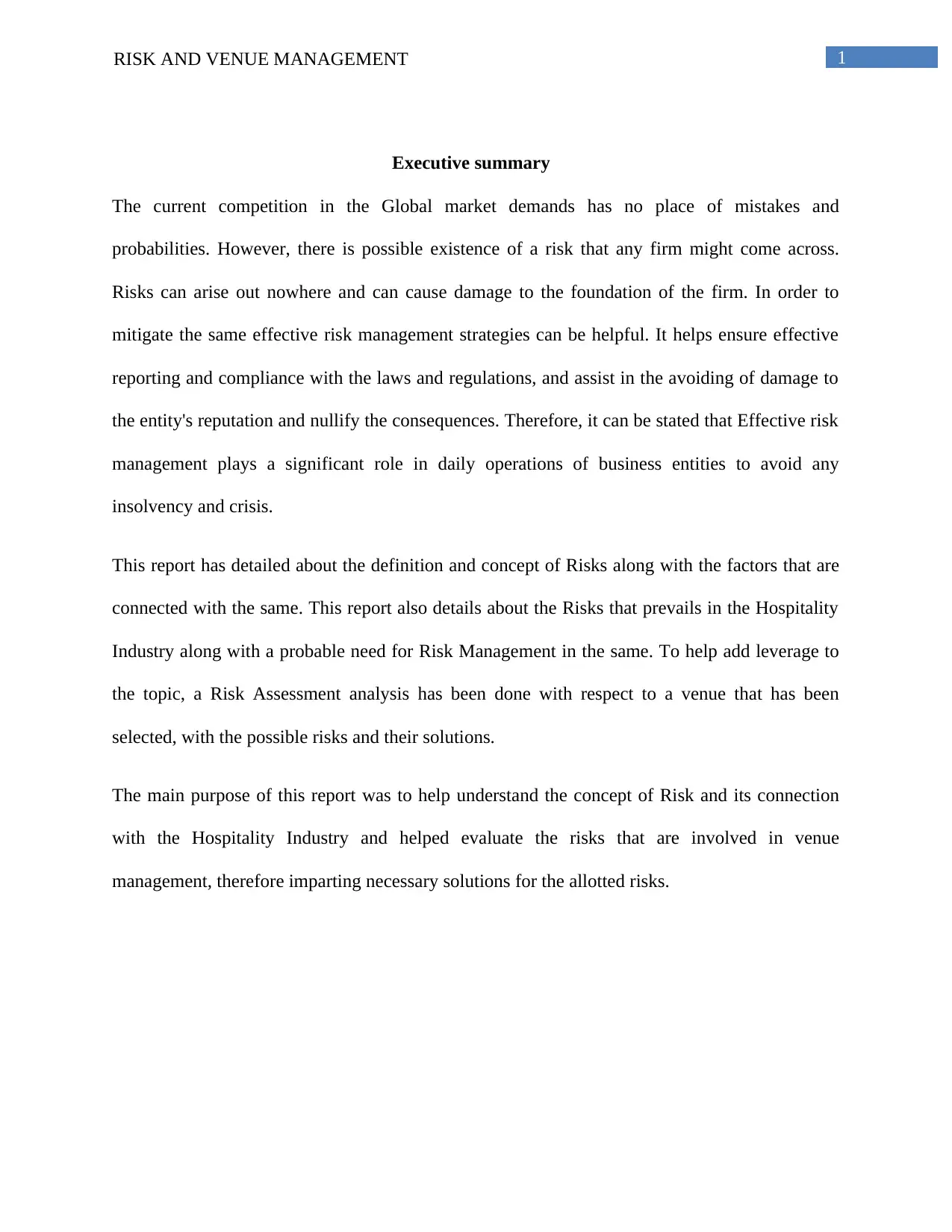
1RISK AND VENUE MANAGEMENT
Executive summary
The current competition in the Global market demands has no place of mistakes and
probabilities. However, there is possible existence of a risk that any firm might come across.
Risks can arise out nowhere and can cause damage to the foundation of the firm. In order to
mitigate the same effective risk management strategies can be helpful. It helps ensure effective
reporting and compliance with the laws and regulations, and assist in the avoiding of damage to
the entity's reputation and nullify the consequences. Therefore, it can be stated that Effective risk
management plays a significant role in daily operations of business entities to avoid any
insolvency and crisis.
This report has detailed about the definition and concept of Risks along with the factors that are
connected with the same. This report also details about the Risks that prevails in the Hospitality
Industry along with a probable need for Risk Management in the same. To help add leverage to
the topic, a Risk Assessment analysis has been done with respect to a venue that has been
selected, with the possible risks and their solutions.
The main purpose of this report was to help understand the concept of Risk and its connection
with the Hospitality Industry and helped evaluate the risks that are involved in venue
management, therefore imparting necessary solutions for the allotted risks.
Executive summary
The current competition in the Global market demands has no place of mistakes and
probabilities. However, there is possible existence of a risk that any firm might come across.
Risks can arise out nowhere and can cause damage to the foundation of the firm. In order to
mitigate the same effective risk management strategies can be helpful. It helps ensure effective
reporting and compliance with the laws and regulations, and assist in the avoiding of damage to
the entity's reputation and nullify the consequences. Therefore, it can be stated that Effective risk
management plays a significant role in daily operations of business entities to avoid any
insolvency and crisis.
This report has detailed about the definition and concept of Risks along with the factors that are
connected with the same. This report also details about the Risks that prevails in the Hospitality
Industry along with a probable need for Risk Management in the same. To help add leverage to
the topic, a Risk Assessment analysis has been done with respect to a venue that has been
selected, with the possible risks and their solutions.
The main purpose of this report was to help understand the concept of Risk and its connection
with the Hospitality Industry and helped evaluate the risks that are involved in venue
management, therefore imparting necessary solutions for the allotted risks.

2RISK AND VENUE MANAGEMENT
Table of contents
Introduction......................................................................................................................................3
Part 1................................................................................................................................................3
Notion of Risk..............................................................................................................................3
Concept of Risk...........................................................................................................................3
Need for Risk Assessment and Management..............................................................................5
Part 2................................................................................................................................................8
Venue Risk Analysis....................................................................................................................8
Introduction to the company, the Star Gold Coast......................................................................8
a. Risk assessment matrix.........................................................................................................9
b. Venue risk analysis.............................................................................................................10
Conclusion.....................................................................................................................................15
References......................................................................................................................................16
Table of contents
Introduction......................................................................................................................................3
Part 1................................................................................................................................................3
Notion of Risk..............................................................................................................................3
Concept of Risk...........................................................................................................................3
Need for Risk Assessment and Management..............................................................................5
Part 2................................................................................................................................................8
Venue Risk Analysis....................................................................................................................8
Introduction to the company, the Star Gold Coast......................................................................8
a. Risk assessment matrix.........................................................................................................9
b. Venue risk analysis.............................................................................................................10
Conclusion.....................................................................................................................................15
References......................................................................................................................................16
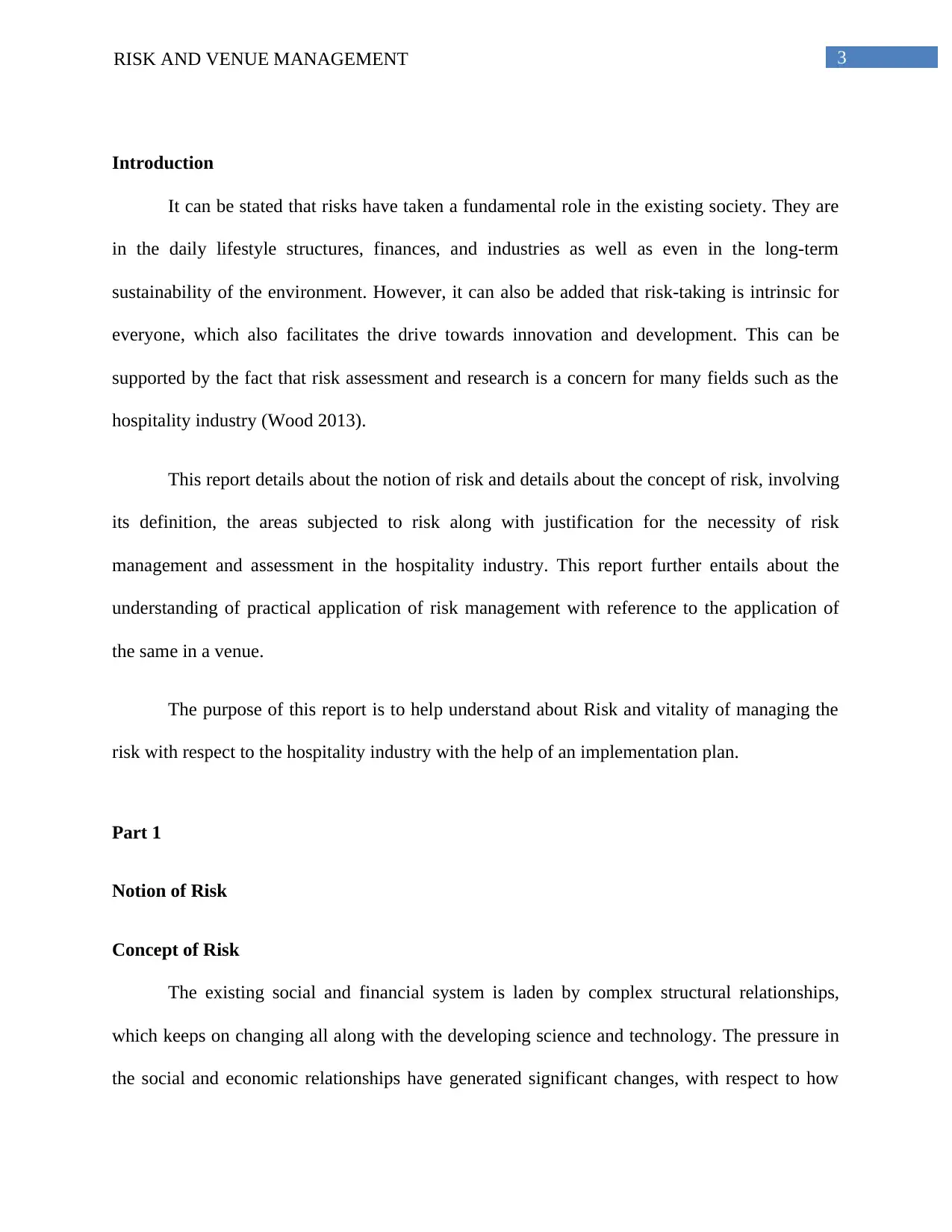
3RISK AND VENUE MANAGEMENT
Introduction
It can be stated that risks have taken a fundamental role in the existing society. They are
in the daily lifestyle structures, finances, and industries as well as even in the long-term
sustainability of the environment. However, it can also be added that risk-taking is intrinsic for
everyone, which also facilitates the drive towards innovation and development. This can be
supported by the fact that risk assessment and research is a concern for many fields such as the
hospitality industry (Wood 2013).
This report details about the notion of risk and details about the concept of risk, involving
its definition, the areas subjected to risk along with justification for the necessity of risk
management and assessment in the hospitality industry. This report further entails about the
understanding of practical application of risk management with reference to the application of
the same in a venue.
The purpose of this report is to help understand about Risk and vitality of managing the
risk with respect to the hospitality industry with the help of an implementation plan.
Part 1
Notion of Risk
Concept of Risk
The existing social and financial system is laden by complex structural relationships,
which keeps on changing all along with the developing science and technology. The pressure in
the social and economic relationships have generated significant changes, with respect to how
Introduction
It can be stated that risks have taken a fundamental role in the existing society. They are
in the daily lifestyle structures, finances, and industries as well as even in the long-term
sustainability of the environment. However, it can also be added that risk-taking is intrinsic for
everyone, which also facilitates the drive towards innovation and development. This can be
supported by the fact that risk assessment and research is a concern for many fields such as the
hospitality industry (Wood 2013).
This report details about the notion of risk and details about the concept of risk, involving
its definition, the areas subjected to risk along with justification for the necessity of risk
management and assessment in the hospitality industry. This report further entails about the
understanding of practical application of risk management with reference to the application of
the same in a venue.
The purpose of this report is to help understand about Risk and vitality of managing the
risk with respect to the hospitality industry with the help of an implementation plan.
Part 1
Notion of Risk
Concept of Risk
The existing social and financial system is laden by complex structural relationships,
which keeps on changing all along with the developing science and technology. The pressure in
the social and economic relationships have generated significant changes, with respect to how
Secure Best Marks with AI Grader
Need help grading? Try our AI Grader for instant feedback on your assignments.
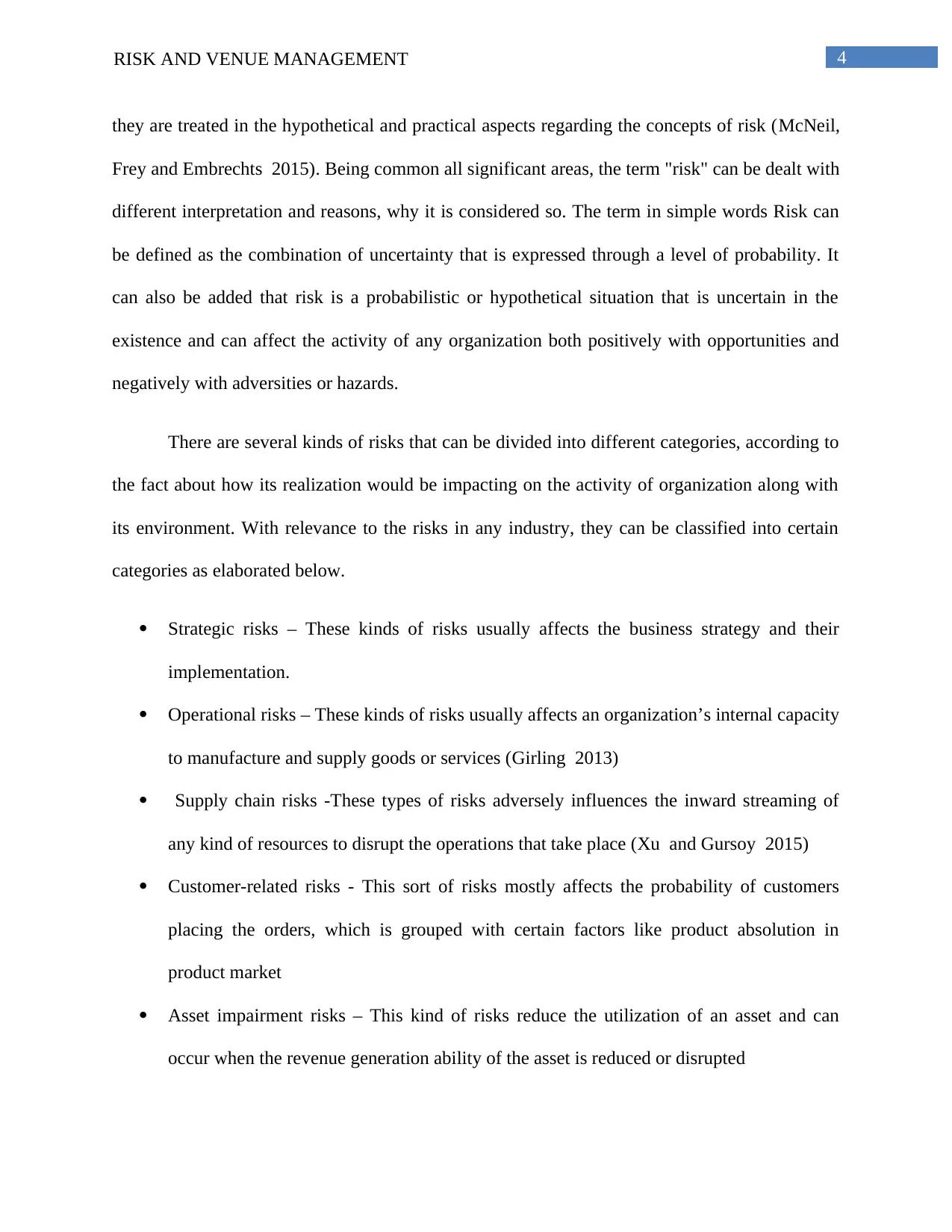
4RISK AND VENUE MANAGEMENT
they are treated in the hypothetical and practical aspects regarding the concepts of risk (McNeil,
Frey and Embrechts 2015). Being common all significant areas, the term "risk" can be dealt with
different interpretation and reasons, why it is considered so. The term in simple words Risk can
be defined as the combination of uncertainty that is expressed through a level of probability. It
can also be added that risk is a probabilistic or hypothetical situation that is uncertain in the
existence and can affect the activity of any organization both positively with opportunities and
negatively with adversities or hazards.
There are several kinds of risks that can be divided into different categories, according to
the fact about how its realization would be impacting on the activity of organization along with
its environment. With relevance to the risks in any industry, they can be classified into certain
categories as elaborated below.
Strategic risks – These kinds of risks usually affects the business strategy and their
implementation.
Operational risks – These kinds of risks usually affects an organization’s internal capacity
to manufacture and supply goods or services (Girling 2013)
Supply chain risks -These types of risks adversely influences the inward streaming of
any kind of resources to disrupt the operations that take place (Xu and Gursoy 2015)
Customer-related risks - This sort of risks mostly affects the probability of customers
placing the orders, which is grouped with certain factors like product absolution in
product market
Asset impairment risks – This kind of risks reduce the utilization of an asset and can
occur when the revenue generation ability of the asset is reduced or disrupted
they are treated in the hypothetical and practical aspects regarding the concepts of risk (McNeil,
Frey and Embrechts 2015). Being common all significant areas, the term "risk" can be dealt with
different interpretation and reasons, why it is considered so. The term in simple words Risk can
be defined as the combination of uncertainty that is expressed through a level of probability. It
can also be added that risk is a probabilistic or hypothetical situation that is uncertain in the
existence and can affect the activity of any organization both positively with opportunities and
negatively with adversities or hazards.
There are several kinds of risks that can be divided into different categories, according to
the fact about how its realization would be impacting on the activity of organization along with
its environment. With relevance to the risks in any industry, they can be classified into certain
categories as elaborated below.
Strategic risks – These kinds of risks usually affects the business strategy and their
implementation.
Operational risks – These kinds of risks usually affects an organization’s internal capacity
to manufacture and supply goods or services (Girling 2013)
Supply chain risks -These types of risks adversely influences the inward streaming of
any kind of resources to disrupt the operations that take place (Xu and Gursoy 2015)
Customer-related risks - This sort of risks mostly affects the probability of customers
placing the orders, which is grouped with certain factors like product absolution in
product market
Asset impairment risks – This kind of risks reduce the utilization of an asset and can
occur when the revenue generation ability of the asset is reduced or disrupted

5RISK AND VENUE MANAGEMENT
Competitive risks – This influences a firm’s capability to distinguish its products/services
from its respective competitors in the similar industry (Benavides-Velasco, Quintana-
García and Marchante-Lara 2014)
Reputation risks – This sort of risks mostly disintegrates the value of entire business due
to loss of assurance and reliability
Financial risk – Financial risks generally exposes a firm to probable loss through the
transformation in the financial markets as well as it can also arise due to specific
debt/loan defaults (Legohérel, Fyall and Poutier 2013)
Fiscal risk – Fiscal risks can arise due to the changes in the taxation regulations
Regulatory risk – This type of risks mostly exposes a firm with the changes in the allotted
regulations, resulting in the affecting of the firm’s business. One of the regulatory risks
can be environmental regulation (Bellini and Di Bernardino 2017)
Legal risks – These risks mainly exposes a firm to proceedings/lawsuits due to actions
arising from the firm’s customers, suppliers, shareholders or even employees
Need for Risk Assessment and Management
Based on the different classifications of risks as mentioned above, the hospitality industry
also faces certain crucial risks that can prove hazardous for the company, which means the
urgency in the need for risk assessment and management (Van der Wagen and Goonetilleke
2015). Some of the noteworthy risks that are faced by the firms in the hospitality industry are
elaborated below.
Data theft or Fraud - As per secondary research, it has been found that the hospitality
industry is the most vulnerable industry where theft or fraudulent activities have been
prevailing due to an environment of easy money making by scamsters. Firms in the
Competitive risks – This influences a firm’s capability to distinguish its products/services
from its respective competitors in the similar industry (Benavides-Velasco, Quintana-
García and Marchante-Lara 2014)
Reputation risks – This sort of risks mostly disintegrates the value of entire business due
to loss of assurance and reliability
Financial risk – Financial risks generally exposes a firm to probable loss through the
transformation in the financial markets as well as it can also arise due to specific
debt/loan defaults (Legohérel, Fyall and Poutier 2013)
Fiscal risk – Fiscal risks can arise due to the changes in the taxation regulations
Regulatory risk – This type of risks mostly exposes a firm with the changes in the allotted
regulations, resulting in the affecting of the firm’s business. One of the regulatory risks
can be environmental regulation (Bellini and Di Bernardino 2017)
Legal risks – These risks mainly exposes a firm to proceedings/lawsuits due to actions
arising from the firm’s customers, suppliers, shareholders or even employees
Need for Risk Assessment and Management
Based on the different classifications of risks as mentioned above, the hospitality industry
also faces certain crucial risks that can prove hazardous for the company, which means the
urgency in the need for risk assessment and management (Van der Wagen and Goonetilleke
2015). Some of the noteworthy risks that are faced by the firms in the hospitality industry are
elaborated below.
Data theft or Fraud - As per secondary research, it has been found that the hospitality
industry is the most vulnerable industry where theft or fraudulent activities have been
prevailing due to an environment of easy money making by scamsters. Firms in the
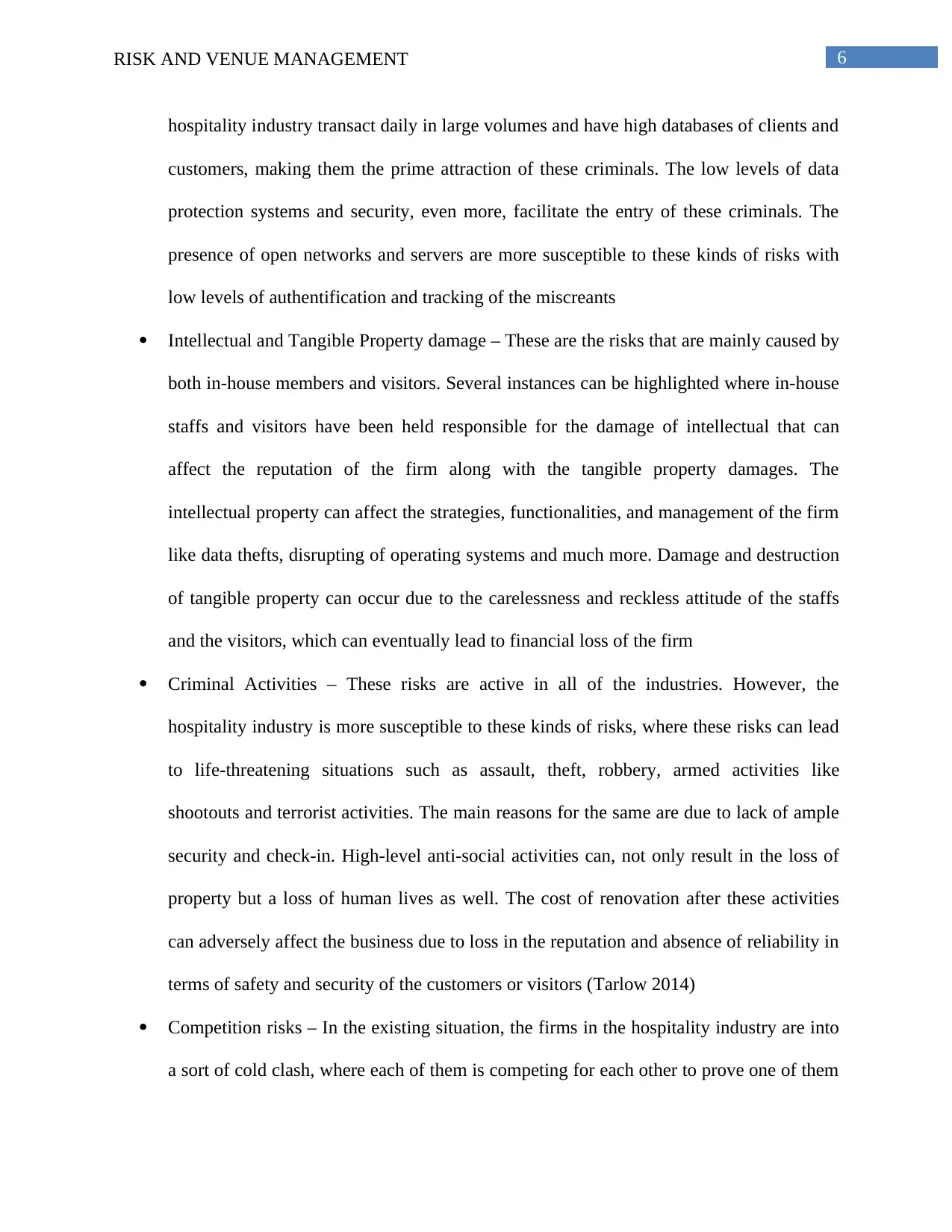
6RISK AND VENUE MANAGEMENT
hospitality industry transact daily in large volumes and have high databases of clients and
customers, making them the prime attraction of these criminals. The low levels of data
protection systems and security, even more, facilitate the entry of these criminals. The
presence of open networks and servers are more susceptible to these kinds of risks with
low levels of authentification and tracking of the miscreants
Intellectual and Tangible Property damage – These are the risks that are mainly caused by
both in-house members and visitors. Several instances can be highlighted where in-house
staffs and visitors have been held responsible for the damage of intellectual that can
affect the reputation of the firm along with the tangible property damages. The
intellectual property can affect the strategies, functionalities, and management of the firm
like data thefts, disrupting of operating systems and much more. Damage and destruction
of tangible property can occur due to the carelessness and reckless attitude of the staffs
and the visitors, which can eventually lead to financial loss of the firm
Criminal Activities – These risks are active in all of the industries. However, the
hospitality industry is more susceptible to these kinds of risks, where these risks can lead
to life-threatening situations such as assault, theft, robbery, armed activities like
shootouts and terrorist activities. The main reasons for the same are due to lack of ample
security and check-in. High-level anti-social activities can, not only result in the loss of
property but a loss of human lives as well. The cost of renovation after these activities
can adversely affect the business due to loss in the reputation and absence of reliability in
terms of safety and security of the customers or visitors (Tarlow 2014)
Competition risks – In the existing situation, the firms in the hospitality industry are into
a sort of cold clash, where each of them is competing for each other to prove one of them
hospitality industry transact daily in large volumes and have high databases of clients and
customers, making them the prime attraction of these criminals. The low levels of data
protection systems and security, even more, facilitate the entry of these criminals. The
presence of open networks and servers are more susceptible to these kinds of risks with
low levels of authentification and tracking of the miscreants
Intellectual and Tangible Property damage – These are the risks that are mainly caused by
both in-house members and visitors. Several instances can be highlighted where in-house
staffs and visitors have been held responsible for the damage of intellectual that can
affect the reputation of the firm along with the tangible property damages. The
intellectual property can affect the strategies, functionalities, and management of the firm
like data thefts, disrupting of operating systems and much more. Damage and destruction
of tangible property can occur due to the carelessness and reckless attitude of the staffs
and the visitors, which can eventually lead to financial loss of the firm
Criminal Activities – These risks are active in all of the industries. However, the
hospitality industry is more susceptible to these kinds of risks, where these risks can lead
to life-threatening situations such as assault, theft, robbery, armed activities like
shootouts and terrorist activities. The main reasons for the same are due to lack of ample
security and check-in. High-level anti-social activities can, not only result in the loss of
property but a loss of human lives as well. The cost of renovation after these activities
can adversely affect the business due to loss in the reputation and absence of reliability in
terms of safety and security of the customers or visitors (Tarlow 2014)
Competition risks – In the existing situation, the firms in the hospitality industry are into
a sort of cold clash, where each of them is competing for each other to prove one of them
Paraphrase This Document
Need a fresh take? Get an instant paraphrase of this document with our AI Paraphraser
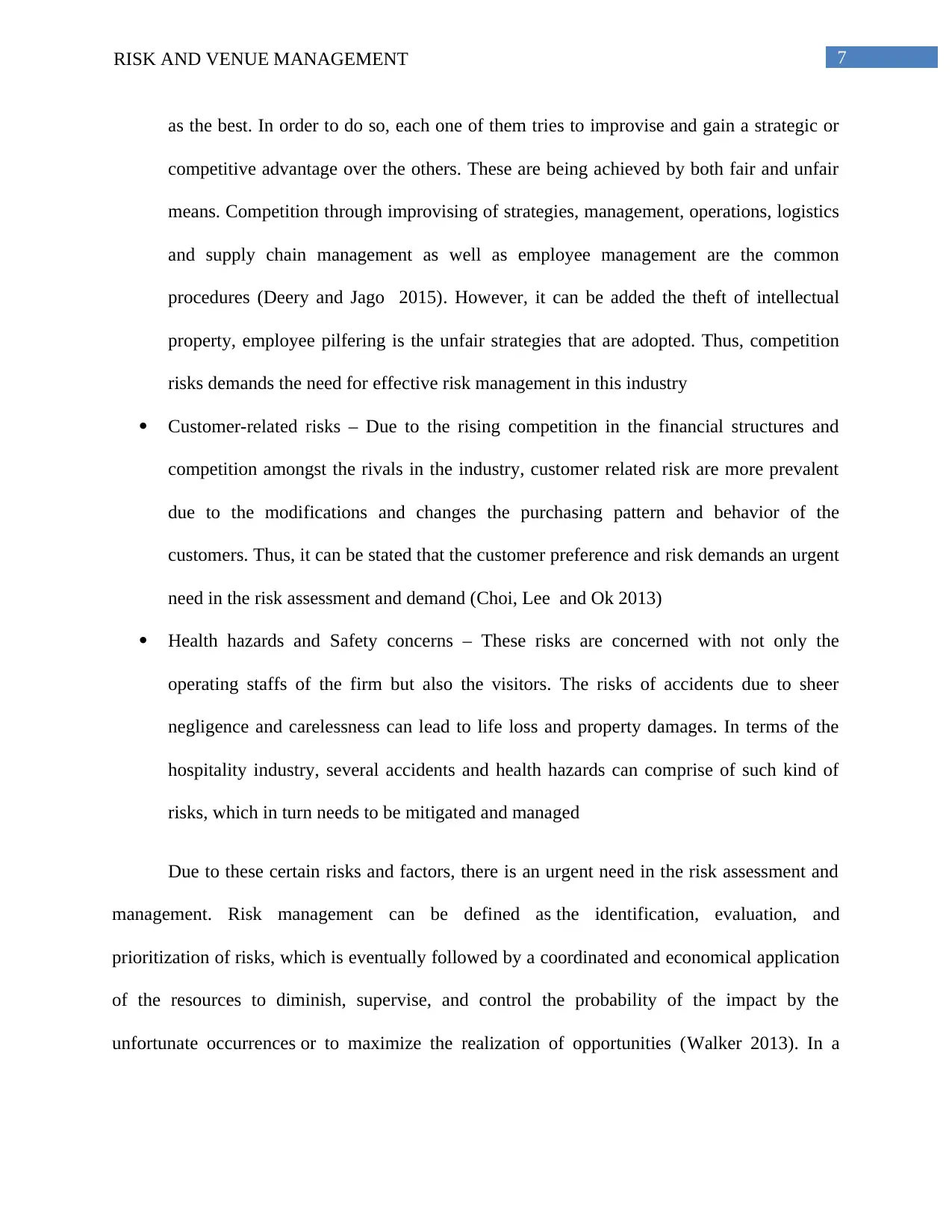
7RISK AND VENUE MANAGEMENT
as the best. In order to do so, each one of them tries to improvise and gain a strategic or
competitive advantage over the others. These are being achieved by both fair and unfair
means. Competition through improvising of strategies, management, operations, logistics
and supply chain management as well as employee management are the common
procedures (Deery and Jago 2015). However, it can be added the theft of intellectual
property, employee pilfering is the unfair strategies that are adopted. Thus, competition
risks demands the need for effective risk management in this industry
Customer-related risks – Due to the rising competition in the financial structures and
competition amongst the rivals in the industry, customer related risk are more prevalent
due to the modifications and changes the purchasing pattern and behavior of the
customers. Thus, it can be stated that the customer preference and risk demands an urgent
need in the risk assessment and demand (Choi, Lee and Ok 2013)
Health hazards and Safety concerns – These risks are concerned with not only the
operating staffs of the firm but also the visitors. The risks of accidents due to sheer
negligence and carelessness can lead to life loss and property damages. In terms of the
hospitality industry, several accidents and health hazards can comprise of such kind of
risks, which in turn needs to be mitigated and managed
Due to these certain risks and factors, there is an urgent need in the risk assessment and
management. Risk management can be defined as the identification, evaluation, and
prioritization of risks, which is eventually followed by a coordinated and economical application
of the resources to diminish, supervise, and control the probability of the impact by the
unfortunate occurrences or to maximize the realization of opportunities (Walker 2013). In a
as the best. In order to do so, each one of them tries to improvise and gain a strategic or
competitive advantage over the others. These are being achieved by both fair and unfair
means. Competition through improvising of strategies, management, operations, logistics
and supply chain management as well as employee management are the common
procedures (Deery and Jago 2015). However, it can be added the theft of intellectual
property, employee pilfering is the unfair strategies that are adopted. Thus, competition
risks demands the need for effective risk management in this industry
Customer-related risks – Due to the rising competition in the financial structures and
competition amongst the rivals in the industry, customer related risk are more prevalent
due to the modifications and changes the purchasing pattern and behavior of the
customers. Thus, it can be stated that the customer preference and risk demands an urgent
need in the risk assessment and demand (Choi, Lee and Ok 2013)
Health hazards and Safety concerns – These risks are concerned with not only the
operating staffs of the firm but also the visitors. The risks of accidents due to sheer
negligence and carelessness can lead to life loss and property damages. In terms of the
hospitality industry, several accidents and health hazards can comprise of such kind of
risks, which in turn needs to be mitigated and managed
Due to these certain risks and factors, there is an urgent need in the risk assessment and
management. Risk management can be defined as the identification, evaluation, and
prioritization of risks, which is eventually followed by a coordinated and economical application
of the resources to diminish, supervise, and control the probability of the impact by the
unfortunate occurrences or to maximize the realization of opportunities (Walker 2013). In a
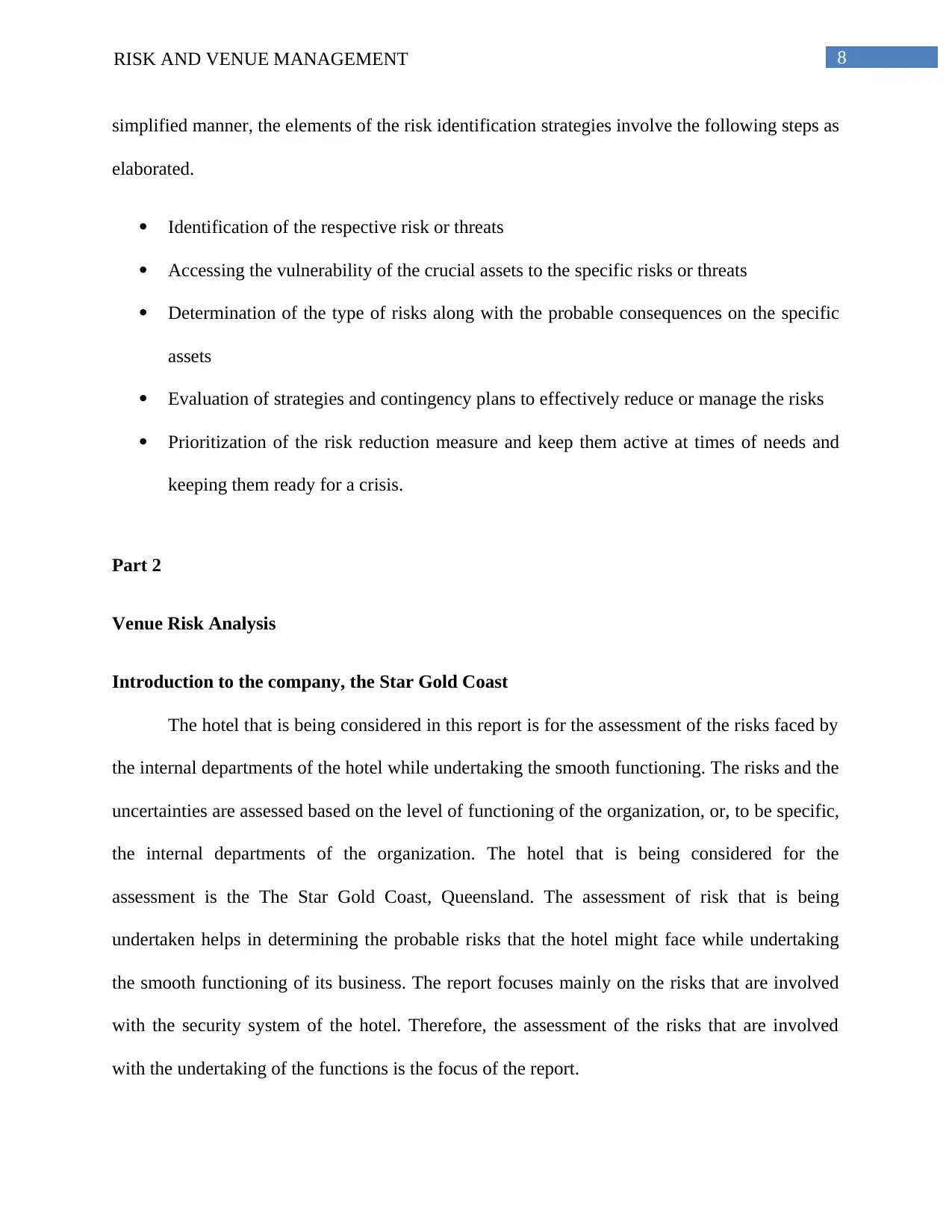
8RISK AND VENUE MANAGEMENT
simplified manner, the elements of the risk identification strategies involve the following steps as
elaborated.
Identification of the respective risk or threats
Accessing the vulnerability of the crucial assets to the specific risks or threats
Determination of the type of risks along with the probable consequences on the specific
assets
Evaluation of strategies and contingency plans to effectively reduce or manage the risks
Prioritization of the risk reduction measure and keep them active at times of needs and
keeping them ready for a crisis.
Part 2
Venue Risk Analysis
Introduction to the company, the Star Gold Coast
The hotel that is being considered in this report is for the assessment of the risks faced by
the internal departments of the hotel while undertaking the smooth functioning. The risks and the
uncertainties are assessed based on the level of functioning of the organization, or, to be specific,
the internal departments of the organization. The hotel that is being considered for the
assessment is the The Star Gold Coast, Queensland. The assessment of risk that is being
undertaken helps in determining the probable risks that the hotel might face while undertaking
the smooth functioning of its business. The report focuses mainly on the risks that are involved
with the security system of the hotel. Therefore, the assessment of the risks that are involved
with the undertaking of the functions is the focus of the report.
simplified manner, the elements of the risk identification strategies involve the following steps as
elaborated.
Identification of the respective risk or threats
Accessing the vulnerability of the crucial assets to the specific risks or threats
Determination of the type of risks along with the probable consequences on the specific
assets
Evaluation of strategies and contingency plans to effectively reduce or manage the risks
Prioritization of the risk reduction measure and keep them active at times of needs and
keeping them ready for a crisis.
Part 2
Venue Risk Analysis
Introduction to the company, the Star Gold Coast
The hotel that is being considered in this report is for the assessment of the risks faced by
the internal departments of the hotel while undertaking the smooth functioning. The risks and the
uncertainties are assessed based on the level of functioning of the organization, or, to be specific,
the internal departments of the organization. The hotel that is being considered for the
assessment is the The Star Gold Coast, Queensland. The assessment of risk that is being
undertaken helps in determining the probable risks that the hotel might face while undertaking
the smooth functioning of its business. The report focuses mainly on the risks that are involved
with the security system of the hotel. Therefore, the assessment of the risks that are involved
with the undertaking of the functions is the focus of the report.
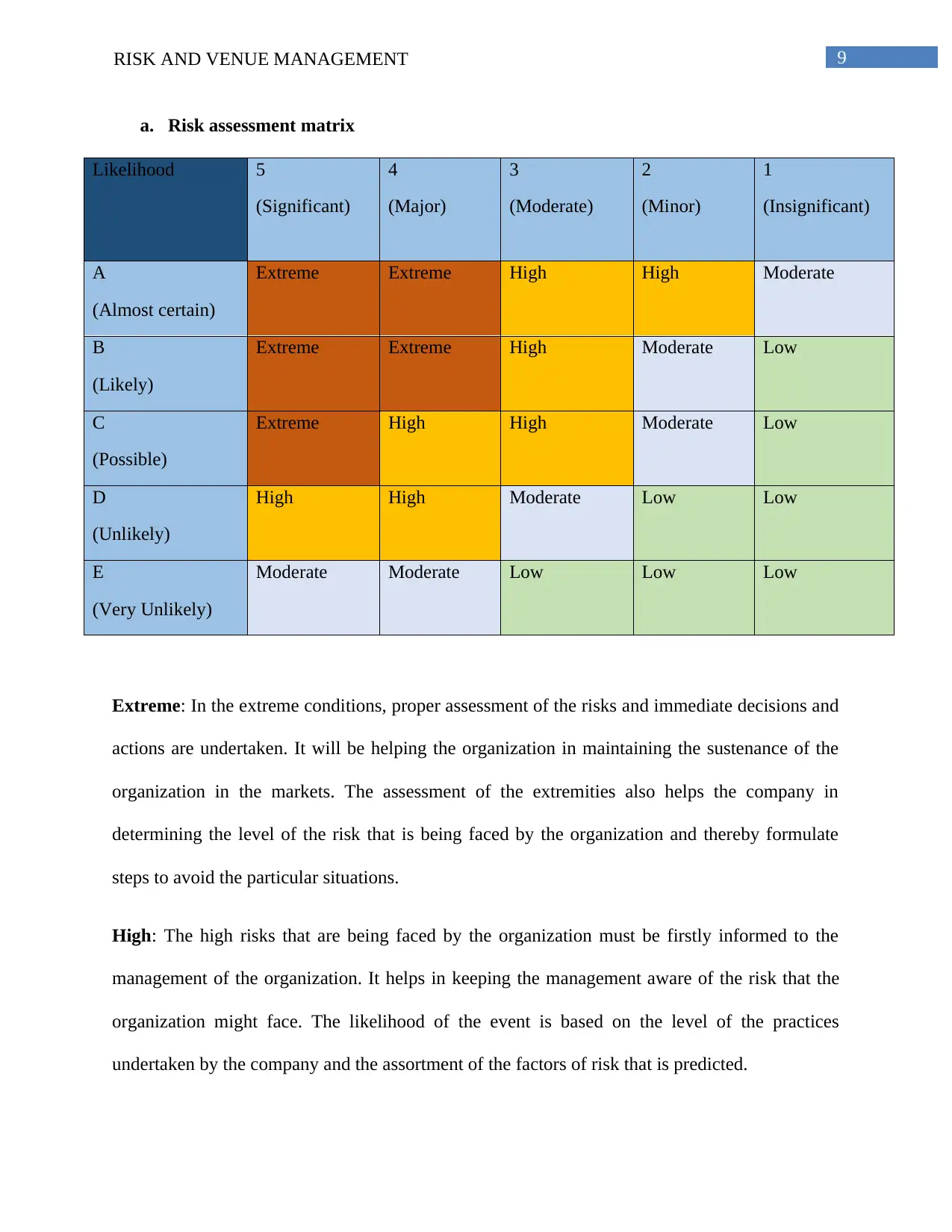
9RISK AND VENUE MANAGEMENT
a. Risk assessment matrix
Likelihood 5
(Significant)
4
(Major)
3
(Moderate)
2
(Minor)
1
(Insignificant)
A
(Almost certain)
Extreme Extreme High High Moderate
B
(Likely)
Extreme Extreme High Moderate Low
C
(Possible)
Extreme High High Moderate Low
D
(Unlikely)
High High Moderate Low Low
E
(Very Unlikely)
Moderate Moderate Low Low Low
Extreme: In the extreme conditions, proper assessment of the risks and immediate decisions and
actions are undertaken. It will be helping the organization in maintaining the sustenance of the
organization in the markets. The assessment of the extremities also helps the company in
determining the level of the risk that is being faced by the organization and thereby formulate
steps to avoid the particular situations.
High: The high risks that are being faced by the organization must be firstly informed to the
management of the organization. It helps in keeping the management aware of the risk that the
organization might face. The likelihood of the event is based on the level of the practices
undertaken by the company and the assortment of the factors of risk that is predicted.
a. Risk assessment matrix
Likelihood 5
(Significant)
4
(Major)
3
(Moderate)
2
(Minor)
1
(Insignificant)
A
(Almost certain)
Extreme Extreme High High Moderate
B
(Likely)
Extreme Extreme High Moderate Low
C
(Possible)
Extreme High High Moderate Low
D
(Unlikely)
High High Moderate Low Low
E
(Very Unlikely)
Moderate Moderate Low Low Low
Extreme: In the extreme conditions, proper assessment of the risks and immediate decisions and
actions are undertaken. It will be helping the organization in maintaining the sustenance of the
organization in the markets. The assessment of the extremities also helps the company in
determining the level of the risk that is being faced by the organization and thereby formulate
steps to avoid the particular situations.
High: The high risks that are being faced by the organization must be firstly informed to the
management of the organization. It helps in keeping the management aware of the risk that the
organization might face. The likelihood of the event is based on the level of the practices
undertaken by the company and the assortment of the factors of risk that is predicted.
Secure Best Marks with AI Grader
Need help grading? Try our AI Grader for instant feedback on your assignments.
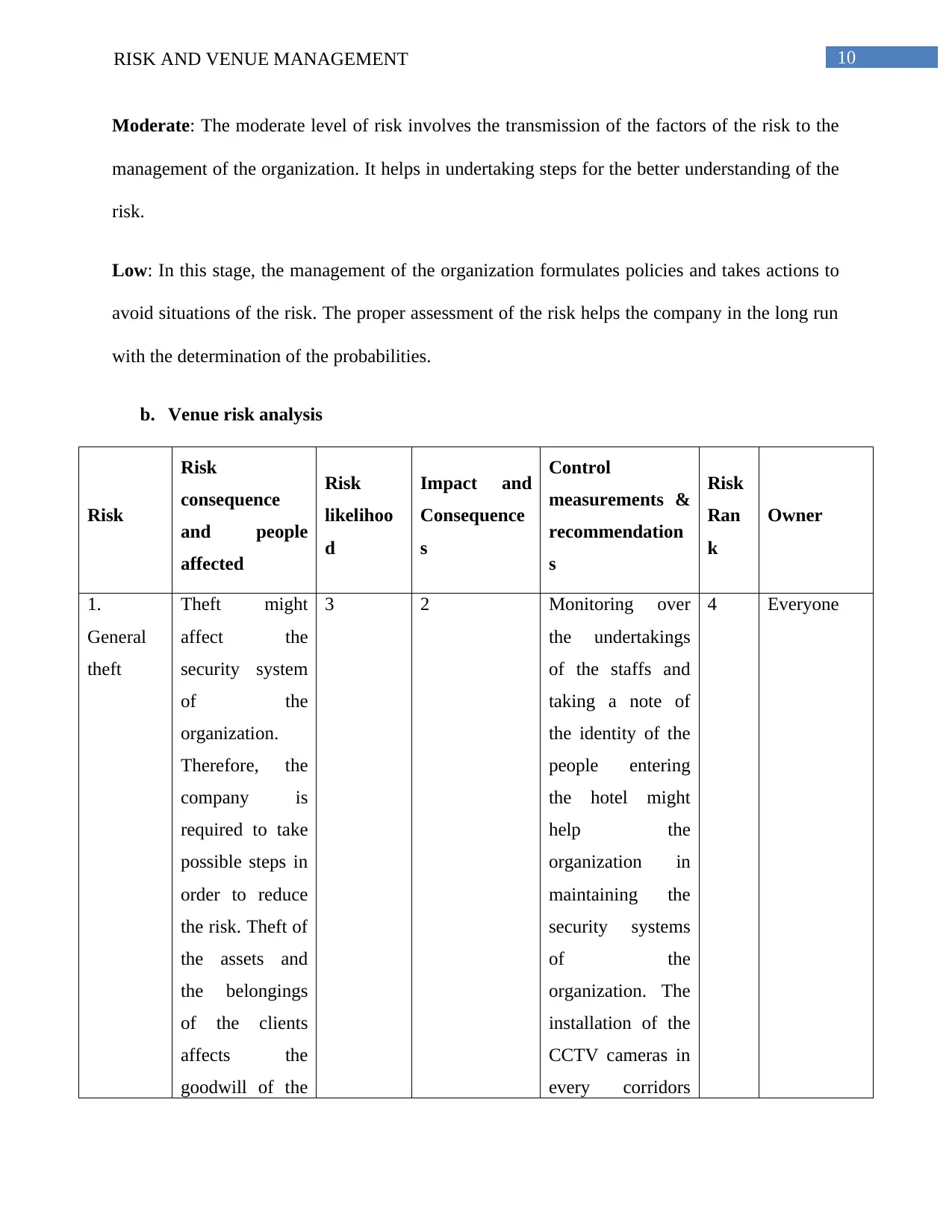
10RISK AND VENUE MANAGEMENT
Moderate: The moderate level of risk involves the transmission of the factors of the risk to the
management of the organization. It helps in undertaking steps for the better understanding of the
risk.
Low: In this stage, the management of the organization formulates policies and takes actions to
avoid situations of the risk. The proper assessment of the risk helps the company in the long run
with the determination of the probabilities.
b. Venue risk analysis
Risk
Risk
consequence
and people
affected
Risk
likelihoo
d
Impact and
Consequence
s
Control
measurements &
recommendation
s
Risk
Ran
k
Owner
1.
General
theft
Theft might
affect the
security system
of the
organization.
Therefore, the
company is
required to take
possible steps in
order to reduce
the risk. Theft of
the assets and
the belongings
of the clients
affects the
goodwill of the
3 2 Monitoring over
the undertakings
of the staffs and
taking a note of
the identity of the
people entering
the hotel might
help the
organization in
maintaining the
security systems
of the
organization. The
installation of the
CCTV cameras in
every corridors
4 Everyone
Moderate: The moderate level of risk involves the transmission of the factors of the risk to the
management of the organization. It helps in undertaking steps for the better understanding of the
risk.
Low: In this stage, the management of the organization formulates policies and takes actions to
avoid situations of the risk. The proper assessment of the risk helps the company in the long run
with the determination of the probabilities.
b. Venue risk analysis
Risk
Risk
consequence
and people
affected
Risk
likelihoo
d
Impact and
Consequence
s
Control
measurements &
recommendation
s
Risk
Ran
k
Owner
1.
General
theft
Theft might
affect the
security system
of the
organization.
Therefore, the
company is
required to take
possible steps in
order to reduce
the risk. Theft of
the assets and
the belongings
of the clients
affects the
goodwill of the
3 2 Monitoring over
the undertakings
of the staffs and
taking a note of
the identity of the
people entering
the hotel might
help the
organization in
maintaining the
security systems
of the
organization. The
installation of the
CCTV cameras in
every corridors
4 Everyone
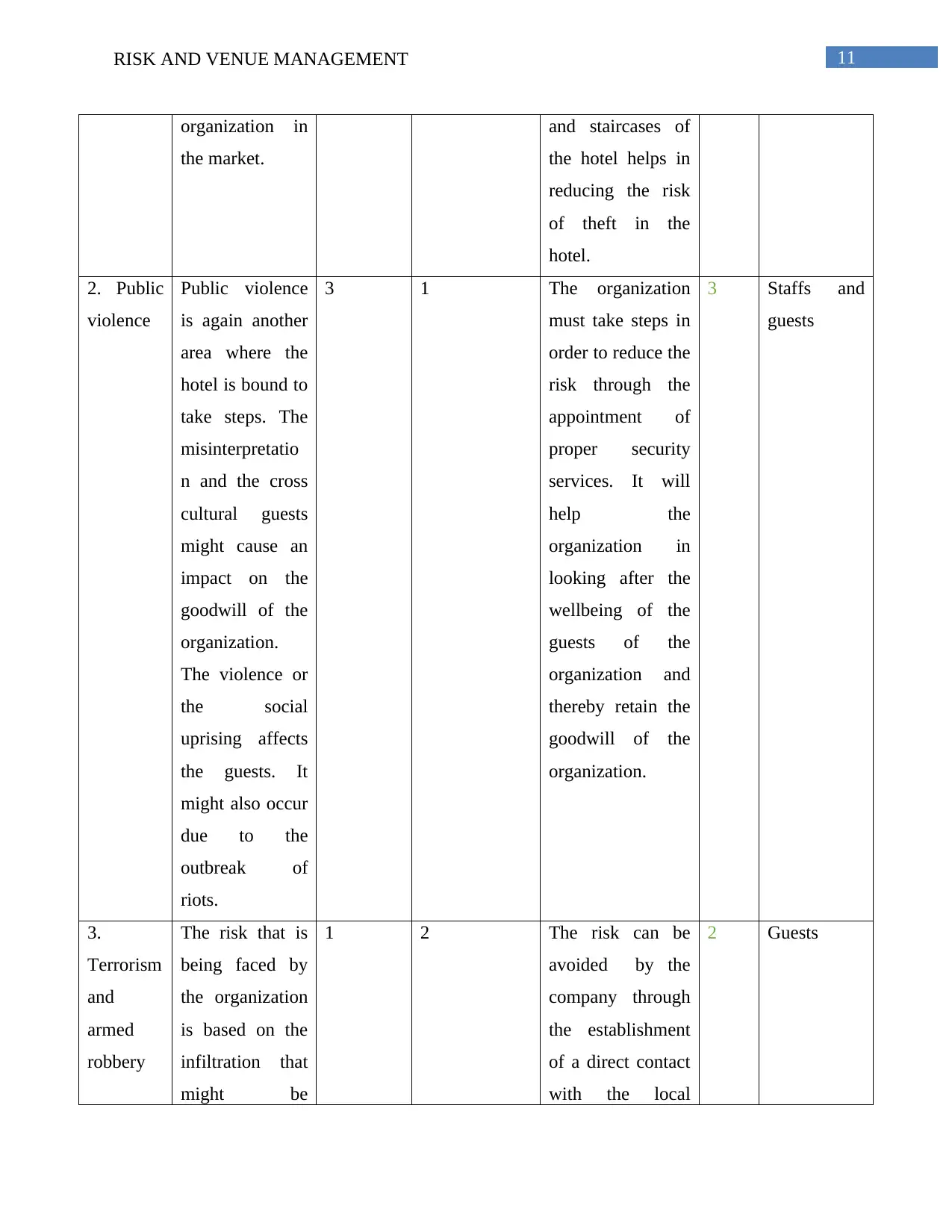
11RISK AND VENUE MANAGEMENT
organization in
the market.
and staircases of
the hotel helps in
reducing the risk
of theft in the
hotel.
2. Public
violence
Public violence
is again another
area where the
hotel is bound to
take steps. The
misinterpretatio
n and the cross
cultural guests
might cause an
impact on the
goodwill of the
organization.
The violence or
the social
uprising affects
the guests. It
might also occur
due to the
outbreak of
riots.
3 1 The organization
must take steps in
order to reduce the
risk through the
appointment of
proper security
services. It will
help the
organization in
looking after the
wellbeing of the
guests of the
organization and
thereby retain the
goodwill of the
organization.
3 Staffs and
guests
3.
Terrorism
and
armed
robbery
The risk that is
being faced by
the organization
is based on the
infiltration that
might be
1 2 The risk can be
avoided by the
company through
the establishment
of a direct contact
with the local
2 Guests
organization in
the market.
and staircases of
the hotel helps in
reducing the risk
of theft in the
hotel.
2. Public
violence
Public violence
is again another
area where the
hotel is bound to
take steps. The
misinterpretatio
n and the cross
cultural guests
might cause an
impact on the
goodwill of the
organization.
The violence or
the social
uprising affects
the guests. It
might also occur
due to the
outbreak of
riots.
3 1 The organization
must take steps in
order to reduce the
risk through the
appointment of
proper security
services. It will
help the
organization in
looking after the
wellbeing of the
guests of the
organization and
thereby retain the
goodwill of the
organization.
3 Staffs and
guests
3.
Terrorism
and
armed
robbery
The risk that is
being faced by
the organization
is based on the
infiltration that
might be
1 2 The risk can be
avoided by the
company through
the establishment
of a direct contact
with the local
2 Guests
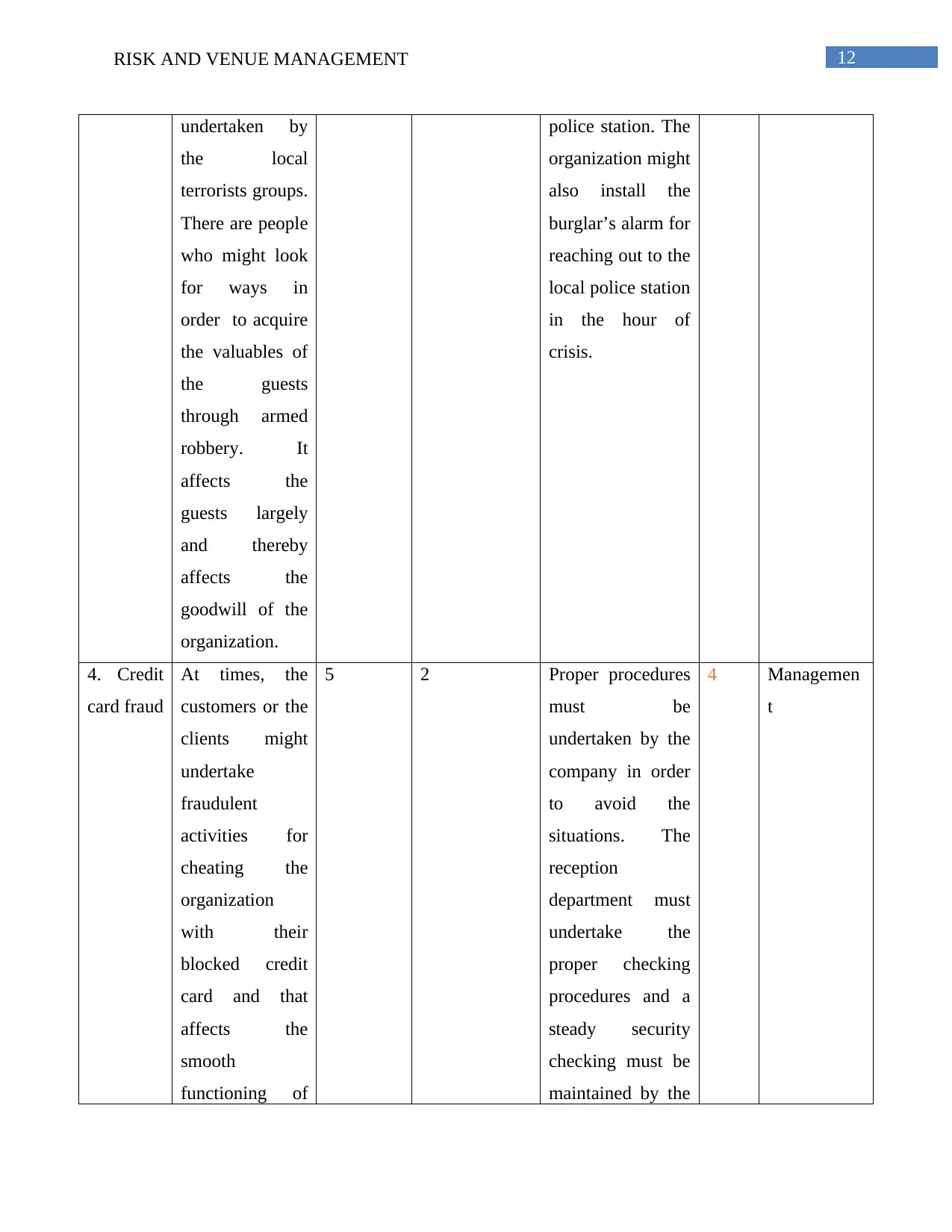
12RISK AND VENUE MANAGEMENT
undertaken by
the local
terrorists groups.
There are people
who might look
for ways in
order to acquire
the valuables of
the guests
through armed
robbery. It
affects the
guests largely
and thereby
affects the
goodwill of the
organization.
police station. The
organization might
also install the
burglar’s alarm for
reaching out to the
local police station
in the hour of
crisis.
4. Credit
card fraud
At times, the
customers or the
clients might
undertake
fraudulent
activities for
cheating the
organization
with their
blocked credit
card and that
affects the
smooth
functioning of
5 2 Proper procedures
must be
undertaken by the
company in order
to avoid the
situations. The
reception
department must
undertake the
proper checking
procedures and a
steady security
checking must be
maintained by the
4 Managemen
t
undertaken by
the local
terrorists groups.
There are people
who might look
for ways in
order to acquire
the valuables of
the guests
through armed
robbery. It
affects the
guests largely
and thereby
affects the
goodwill of the
organization.
police station. The
organization might
also install the
burglar’s alarm for
reaching out to the
local police station
in the hour of
crisis.
4. Credit
card fraud
At times, the
customers or the
clients might
undertake
fraudulent
activities for
cheating the
organization
with their
blocked credit
card and that
affects the
smooth
functioning of
5 2 Proper procedures
must be
undertaken by the
company in order
to avoid the
situations. The
reception
department must
undertake the
proper checking
procedures and a
steady security
checking must be
maintained by the
4 Managemen
t
Paraphrase This Document
Need a fresh take? Get an instant paraphrase of this document with our AI Paraphraser
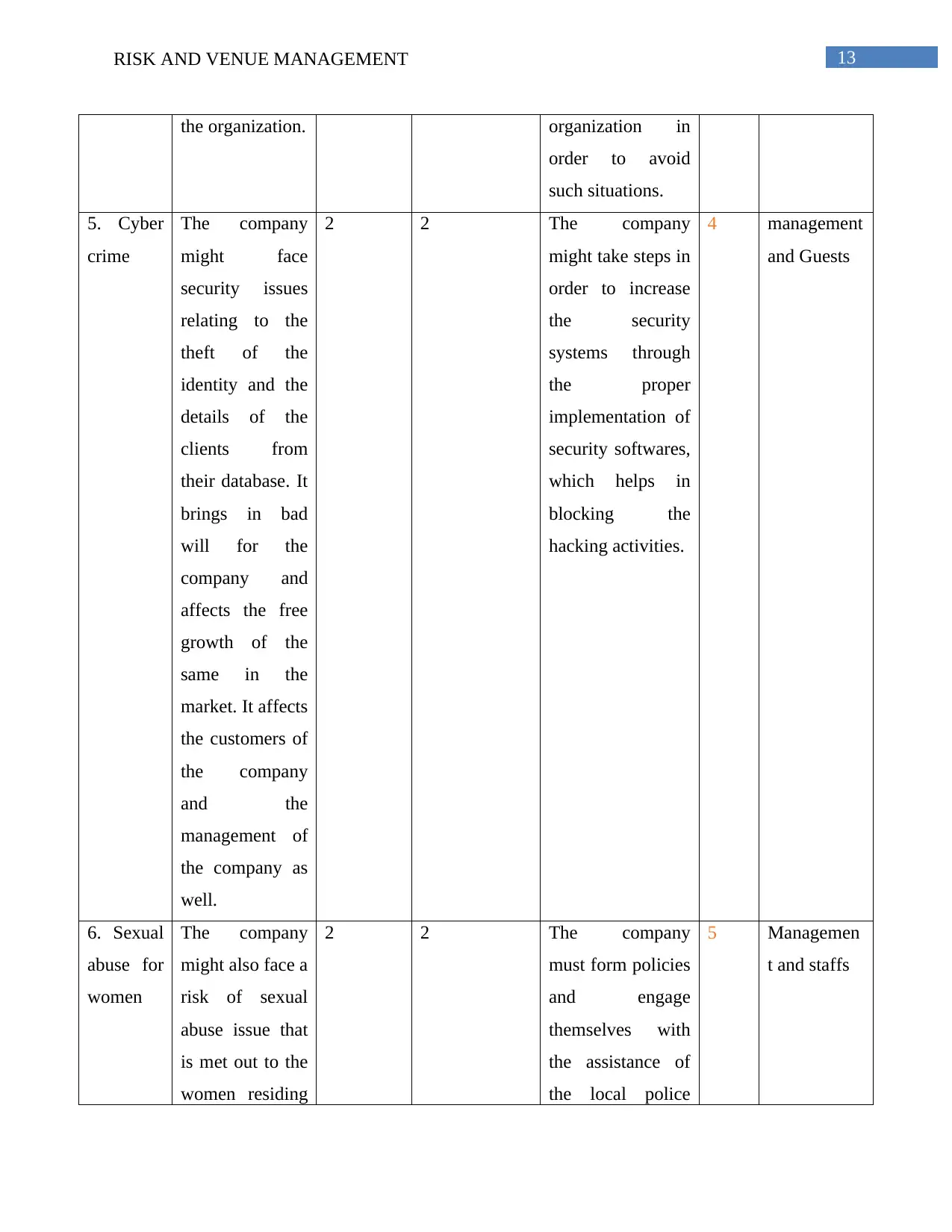
13RISK AND VENUE MANAGEMENT
the organization. organization in
order to avoid
such situations.
5. Cyber
crime
The company
might face
security issues
relating to the
theft of the
identity and the
details of the
clients from
their database. It
brings in bad
will for the
company and
affects the free
growth of the
same in the
market. It affects
the customers of
the company
and the
management of
the company as
well.
2 2 The company
might take steps in
order to increase
the security
systems through
the proper
implementation of
security softwares,
which helps in
blocking the
hacking activities.
4 management
and Guests
6. Sexual
abuse for
women
The company
might also face a
risk of sexual
abuse issue that
is met out to the
women residing
2 2 The company
must form policies
and engage
themselves with
the assistance of
the local police
5 Managemen
t and staffs
the organization. organization in
order to avoid
such situations.
5. Cyber
crime
The company
might face
security issues
relating to the
theft of the
identity and the
details of the
clients from
their database. It
brings in bad
will for the
company and
affects the free
growth of the
same in the
market. It affects
the customers of
the company
and the
management of
the company as
well.
2 2 The company
might take steps in
order to increase
the security
systems through
the proper
implementation of
security softwares,
which helps in
blocking the
hacking activities.
4 management
and Guests
6. Sexual
abuse for
women
The company
might also face a
risk of sexual
abuse issue that
is met out to the
women residing
2 2 The company
must form policies
and engage
themselves with
the assistance of
the local police
5 Managemen
t and staffs
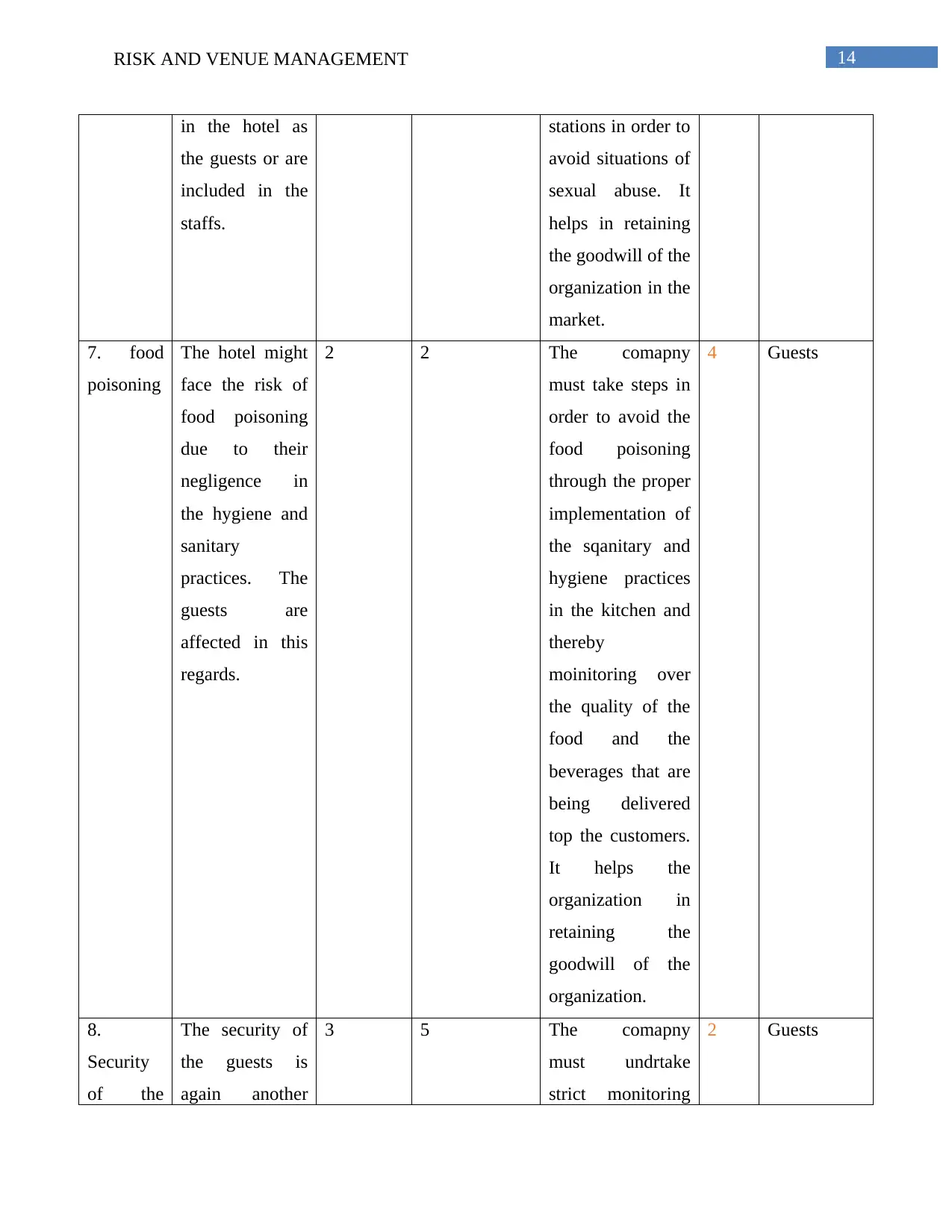
14RISK AND VENUE MANAGEMENT
in the hotel as
the guests or are
included in the
staffs.
stations in order to
avoid situations of
sexual abuse. It
helps in retaining
the goodwill of the
organization in the
market.
7. food
poisoning
The hotel might
face the risk of
food poisoning
due to their
negligence in
the hygiene and
sanitary
practices. The
guests are
affected in this
regards.
2 2 The comapny
must take steps in
order to avoid the
food poisoning
through the proper
implementation of
the sqanitary and
hygiene practices
in the kitchen and
thereby
moinitoring over
the quality of the
food and the
beverages that are
being delivered
top the customers.
It helps the
organization in
retaining the
goodwill of the
organization.
4 Guests
8.
Security
of the
The security of
the guests is
again another
3 5 The comapny
must undrtake
strict monitoring
2 Guests
in the hotel as
the guests or are
included in the
staffs.
stations in order to
avoid situations of
sexual abuse. It
helps in retaining
the goodwill of the
organization in the
market.
7. food
poisoning
The hotel might
face the risk of
food poisoning
due to their
negligence in
the hygiene and
sanitary
practices. The
guests are
affected in this
regards.
2 2 The comapny
must take steps in
order to avoid the
food poisoning
through the proper
implementation of
the sqanitary and
hygiene practices
in the kitchen and
thereby
moinitoring over
the quality of the
food and the
beverages that are
being delivered
top the customers.
It helps the
organization in
retaining the
goodwill of the
organization.
4 Guests
8.
Security
of the
The security of
the guests is
again another
3 5 The comapny
must undrtake
strict monitoring
2 Guests
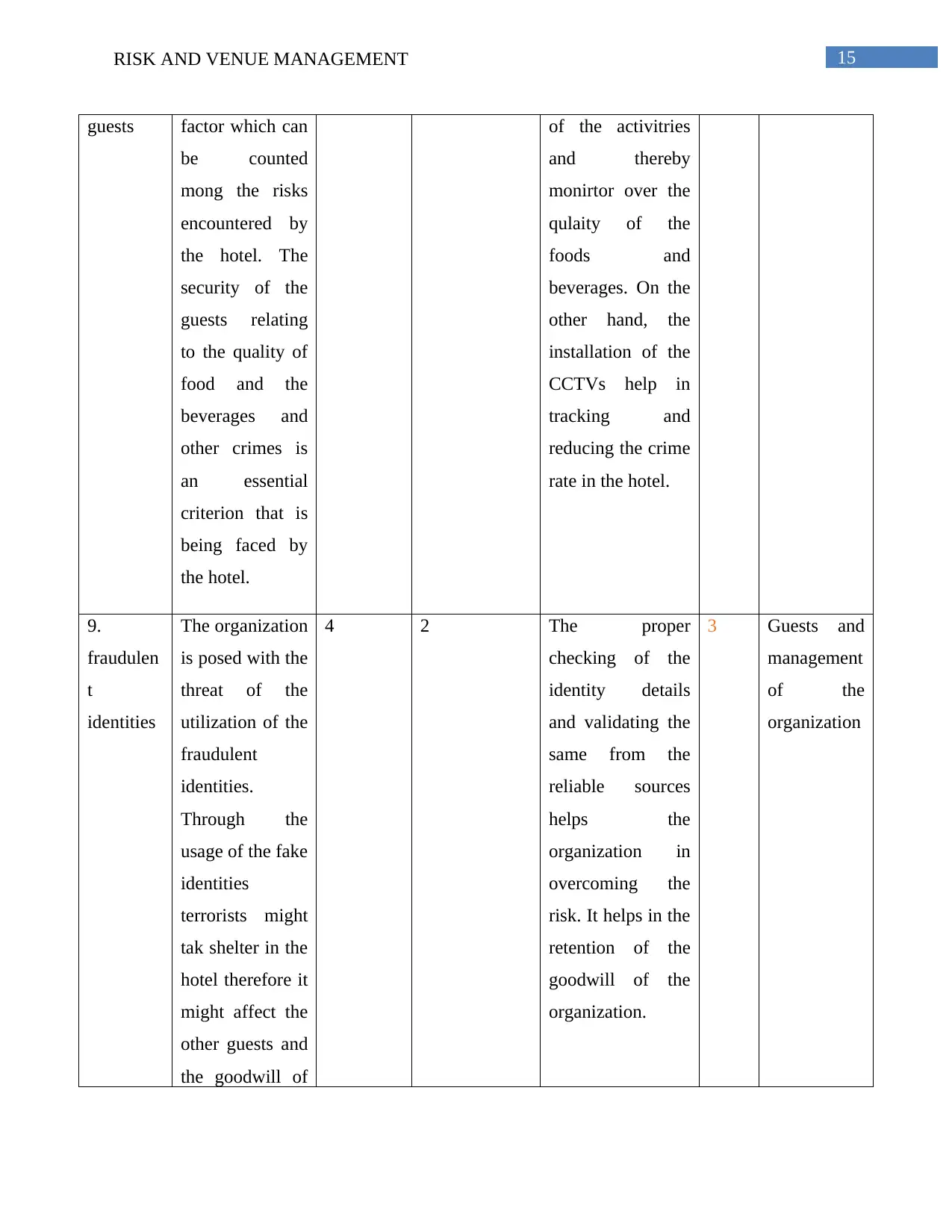
15RISK AND VENUE MANAGEMENT
guests factor which can
be counted
mong the risks
encountered by
the hotel. The
security of the
guests relating
to the quality of
food and the
beverages and
other crimes is
an essential
criterion that is
being faced by
the hotel.
of the activitries
and thereby
monirtor over the
qulaity of the
foods and
beverages. On the
other hand, the
installation of the
CCTVs help in
tracking and
reducing the crime
rate in the hotel.
9.
fraudulen
t
identities
The organization
is posed with the
threat of the
utilization of the
fraudulent
identities.
Through the
usage of the fake
identities
terrorists might
tak shelter in the
hotel therefore it
might affect the
other guests and
the goodwill of
4 2 The proper
checking of the
identity details
and validating the
same from the
reliable sources
helps the
organization in
overcoming the
risk. It helps in the
retention of the
goodwill of the
organization.
3 Guests and
management
of the
organization
guests factor which can
be counted
mong the risks
encountered by
the hotel. The
security of the
guests relating
to the quality of
food and the
beverages and
other crimes is
an essential
criterion that is
being faced by
the hotel.
of the activitries
and thereby
monirtor over the
qulaity of the
foods and
beverages. On the
other hand, the
installation of the
CCTVs help in
tracking and
reducing the crime
rate in the hotel.
9.
fraudulen
t
identities
The organization
is posed with the
threat of the
utilization of the
fraudulent
identities.
Through the
usage of the fake
identities
terrorists might
tak shelter in the
hotel therefore it
might affect the
other guests and
the goodwill of
4 2 The proper
checking of the
identity details
and validating the
same from the
reliable sources
helps the
organization in
overcoming the
risk. It helps in the
retention of the
goodwill of the
organization.
3 Guests and
management
of the
organization
Secure Best Marks with AI Grader
Need help grading? Try our AI Grader for instant feedback on your assignments.
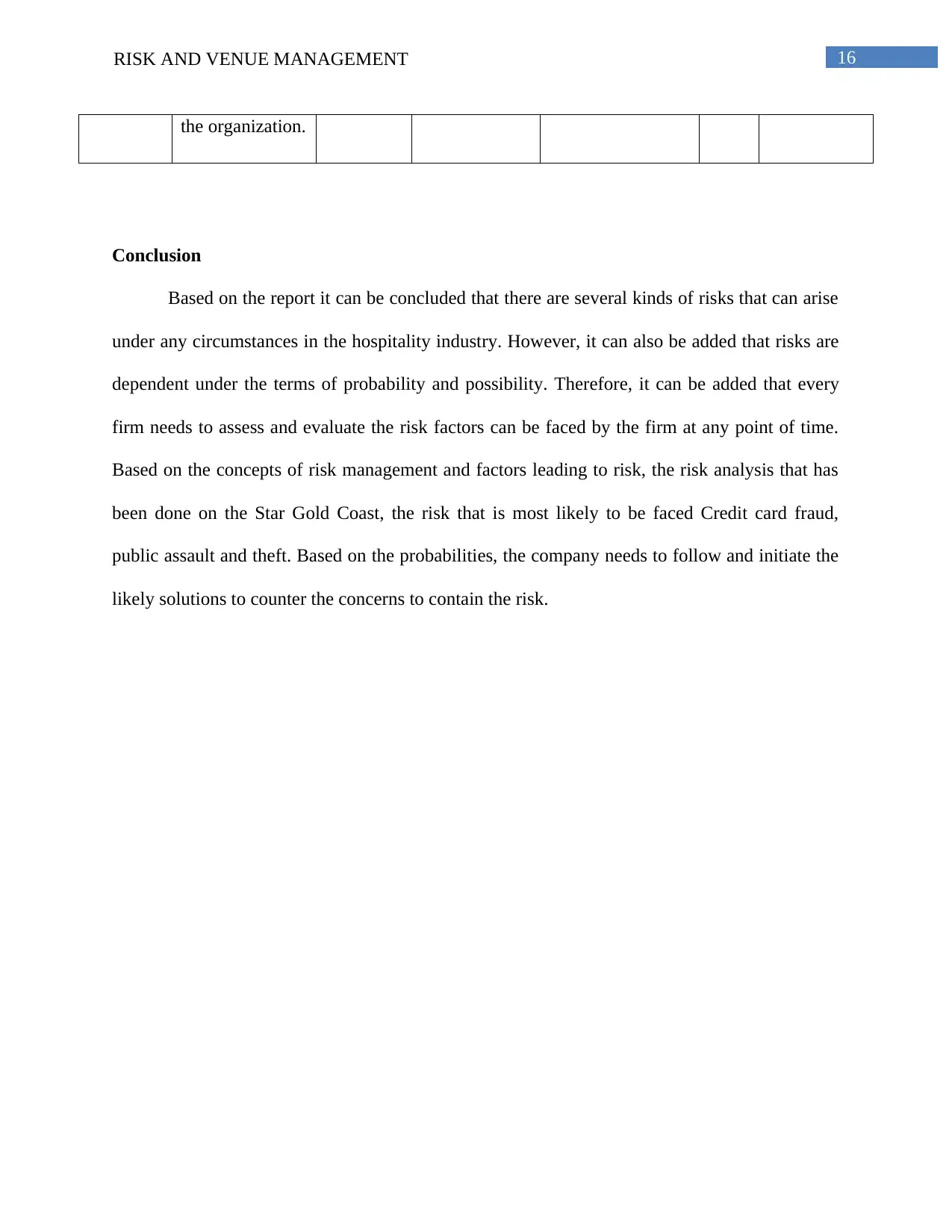
16RISK AND VENUE MANAGEMENT
the organization.
Conclusion
Based on the report it can be concluded that there are several kinds of risks that can arise
under any circumstances in the hospitality industry. However, it can also be added that risks are
dependent under the terms of probability and possibility. Therefore, it can be added that every
firm needs to assess and evaluate the risk factors can be faced by the firm at any point of time.
Based on the concepts of risk management and factors leading to risk, the risk analysis that has
been done on the Star Gold Coast, the risk that is most likely to be faced Credit card fraud,
public assault and theft. Based on the probabilities, the company needs to follow and initiate the
likely solutions to counter the concerns to contain the risk.
the organization.
Conclusion
Based on the report it can be concluded that there are several kinds of risks that can arise
under any circumstances in the hospitality industry. However, it can also be added that risks are
dependent under the terms of probability and possibility. Therefore, it can be added that every
firm needs to assess and evaluate the risk factors can be faced by the firm at any point of time.
Based on the concepts of risk management and factors leading to risk, the risk analysis that has
been done on the Star Gold Coast, the risk that is most likely to be faced Credit card fraud,
public assault and theft. Based on the probabilities, the company needs to follow and initiate the
likely solutions to counter the concerns to contain the risk.
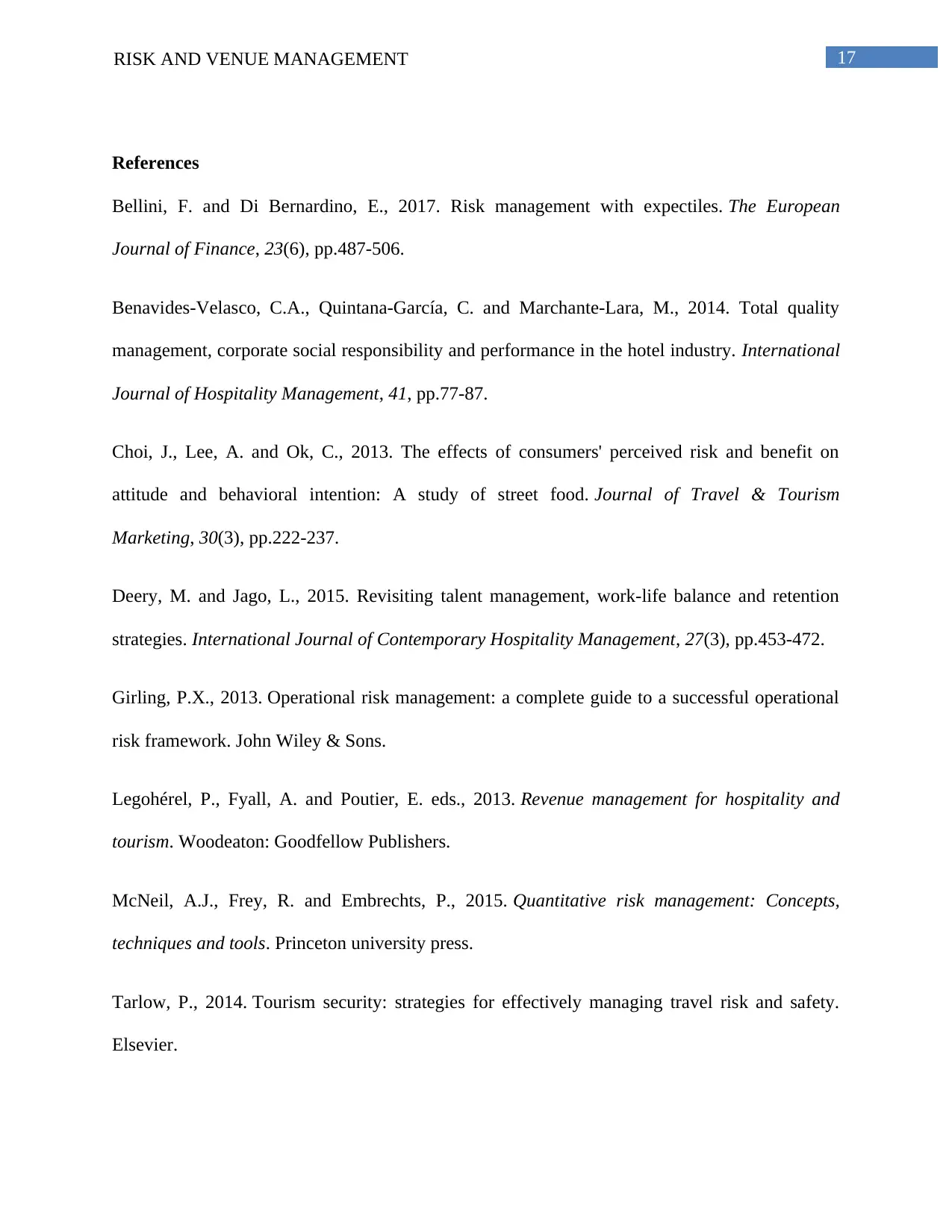
17RISK AND VENUE MANAGEMENT
References
Bellini, F. and Di Bernardino, E., 2017. Risk management with expectiles. The European
Journal of Finance, 23(6), pp.487-506.
Benavides-Velasco, C.A., Quintana-García, C. and Marchante-Lara, M., 2014. Total quality
management, corporate social responsibility and performance in the hotel industry. International
Journal of Hospitality Management, 41, pp.77-87.
Choi, J., Lee, A. and Ok, C., 2013. The effects of consumers' perceived risk and benefit on
attitude and behavioral intention: A study of street food. Journal of Travel & Tourism
Marketing, 30(3), pp.222-237.
Deery, M. and Jago, L., 2015. Revisiting talent management, work-life balance and retention
strategies. International Journal of Contemporary Hospitality Management, 27(3), pp.453-472.
Girling, P.X., 2013. Operational risk management: a complete guide to a successful operational
risk framework. John Wiley & Sons.
Legohérel, P., Fyall, A. and Poutier, E. eds., 2013. Revenue management for hospitality and
tourism. Woodeaton: Goodfellow Publishers.
McNeil, A.J., Frey, R. and Embrechts, P., 2015. Quantitative risk management: Concepts,
techniques and tools. Princeton university press.
Tarlow, P., 2014. Tourism security: strategies for effectively managing travel risk and safety.
Elsevier.
References
Bellini, F. and Di Bernardino, E., 2017. Risk management with expectiles. The European
Journal of Finance, 23(6), pp.487-506.
Benavides-Velasco, C.A., Quintana-García, C. and Marchante-Lara, M., 2014. Total quality
management, corporate social responsibility and performance in the hotel industry. International
Journal of Hospitality Management, 41, pp.77-87.
Choi, J., Lee, A. and Ok, C., 2013. The effects of consumers' perceived risk and benefit on
attitude and behavioral intention: A study of street food. Journal of Travel & Tourism
Marketing, 30(3), pp.222-237.
Deery, M. and Jago, L., 2015. Revisiting talent management, work-life balance and retention
strategies. International Journal of Contemporary Hospitality Management, 27(3), pp.453-472.
Girling, P.X., 2013. Operational risk management: a complete guide to a successful operational
risk framework. John Wiley & Sons.
Legohérel, P., Fyall, A. and Poutier, E. eds., 2013. Revenue management for hospitality and
tourism. Woodeaton: Goodfellow Publishers.
McNeil, A.J., Frey, R. and Embrechts, P., 2015. Quantitative risk management: Concepts,
techniques and tools. Princeton university press.
Tarlow, P., 2014. Tourism security: strategies for effectively managing travel risk and safety.
Elsevier.

18RISK AND VENUE MANAGEMENT
Van der Wagen, L. and Goonetilleke, A., 2015. Hospitality Management, Strategy and
Operations. Pearson Higher Education AU.
Walker, R., 2013. Winning with risk management. World Scientific.
Wood, R.C. ed., 2013. Key concepts in hospitality management. Sage.
Xu, X. and Gursoy, D., 2015. A conceptual framework of sustainable hospitality supply chain
management. Journal of Hospitality Marketing & Management, 24(3), pp.229-259.
Van der Wagen, L. and Goonetilleke, A., 2015. Hospitality Management, Strategy and
Operations. Pearson Higher Education AU.
Walker, R., 2013. Winning with risk management. World Scientific.
Wood, R.C. ed., 2013. Key concepts in hospitality management. Sage.
Xu, X. and Gursoy, D., 2015. A conceptual framework of sustainable hospitality supply chain
management. Journal of Hospitality Marketing & Management, 24(3), pp.229-259.
1 out of 19
Related Documents
Your All-in-One AI-Powered Toolkit for Academic Success.
+13062052269
info@desklib.com
Available 24*7 on WhatsApp / Email
![[object Object]](/_next/static/media/star-bottom.7253800d.svg)
Unlock your academic potential
© 2024 | Zucol Services PVT LTD | All rights reserved.





